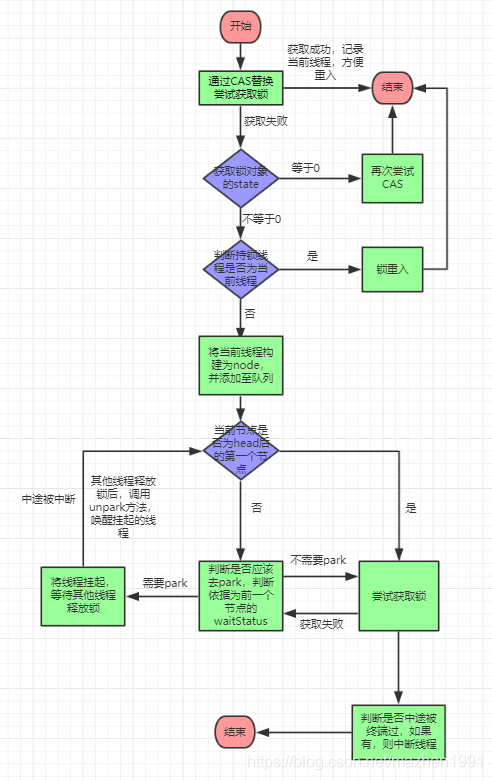AQS简介
java.util.concurrent(J.U.C)大大提高了并发性能,AQS 被认为是 J.U.C 的核心。
AQS就是AbstractQueuedSynchronizer,它是为实现依赖于先进先出(FIFO)等待队列的阻塞锁和相关同步器(信号量,事件等)提供的一个框架。
源码分析
从ReentrantLock进入
可以看到ReentrantLock默认构建了NonfairSync,即非公平锁
public ReentrantLock() {
sync = new NonfairSync();
}
public ReentrantLock(boolean fair) {
sync = fair ? new FairSync() : new NonfairSync();
}
而Sync继承自AbstractQueuedSynchronizer
abstract static class Sync extends AbstractQueuedSynchronizer {}
其实现有NonfairSync和FairSync两种,正好对应ReentrantLock的构造方法
Lock加锁方法
public void lock() {
sync.lock();
}
首先看到其使用了sync.lock(),进入发现根据NonfairSync和FairSync具体有不同实现
// 非公平
final void lock() {
if (compareAndSetState(0, 1))
//如果获取到了,就记录一下当前的线程,以便后面的重入
setExclusiveOwnerThread(Thread.currentThread());
else
acquire(1);
}
// 公平
final void lock() {
acquire(1);
}
这两者区别在于NonfairSync多了一个条件判断compareAndSetState(0, 1),这个方法是判断是否可以直接获取锁(即第一个进入的线程能直接获取锁,也就是非公平的概念),
// 利用cas操作
protected final boolean compareAndSetState(int expect, int update) {
// See below for intrinsics setup to support this
return unsafe.compareAndSwapInt(this, stateOffset, expect, update);
}
// 把当前线程设置成独占线程
protected final void setExclusiveOwnerThread(Thread thread) {
exclusiveOwnerThread = thread;
}
acquire竞争锁
当非公平锁无法独占时,需要和公平锁一样通过调用acquire方法来竞争锁
看位于AQS里面的acquire方法:
- 如果获取到了,返回true,就会退出if语句
- 如果没有获取到,那么则将当前线程添加到队列中,并循环获取锁,直到获取到为止。
public final void acquire(int arg) {
//tryAcquire方法仍然尝试获取锁
if (!tryAcquire(arg) &&
acquireQueued(addWaiter(Node.EXCLUSIVE), arg))
selfInterrupt();
}
tryAcquire在AQS中默认是抛出异常,其是需要其子类实现,
protected boolean tryAcquire(int arg) {
throw new UnsupportedOperationException();
}
非公平锁实现:
protected final boolean tryAcquire(int acquires) {
return nonfairTryAcquire(acquires);
}
/**
* Performs non-fair tryLock. tryAcquire is implemented in
* subclasses, but both need nonfair try for trylock method.
*/
final boolean nonfairTryAcquire(int acquires) {
// 当前线程
final Thread current = Thread.currentThread();
// 获取到锁的标志状态
int c = getState();
// 0代表没有被获取到,则尝试获取
if (c == 0) {
//这里和上面一样尝试获取锁成功,直接返回true
if (compareAndSetState(0, acquires)) {
setExclusiveOwnerThread(current);
return true;
}
}
// 这里判断当前线程是否就是已经获取锁的线程,即可重入
else if (current == getExclusiveOwnerThread()) {
int nextc = c + acquires;
if (nextc < 0) // overflow
throw new Error("Maximum lock count exceeded");
setState(nextc);
return true;
}
// 都不满足返回false
return false;
}
addWaiter添加到队列
当acquire获取锁失败,这利用addWaiter方法把当前线程添加到一个队列中:
/**
* Creates and enqueues node for current thread and given mode.
*
* @param mode Node.EXCLUSIVE for exclusive, Node.SHARED for shared
* @return the new node
*/
private Node addWaiter(Node mode) {
// 使用当前线程创建一个Node节点,mode分为共享和排他
Node node = new Node(Thread.currentThread(), mode);
// Try the fast path of enq; backup to full enq on failure
Node pred = tail;
if (pred != null) {
// 如果队列中已经存在节点了,那么直接将该节点添加到后面
node.prev = pred;
if (compareAndSetTail(pred, node)) {
pred.next = node;
return node;
}
}
// 如果是第一次构建队列,则调用该方法
enq(node);
return node;
}
/**
* Inserts node into queue, initializing if necessary. See picture above.
* @param node the node to insert
* @return node's predecessor
*/
private Node enq(final Node node) {
for (;;) {
Node t = tail;
if (t == null) { // Must initialize
// 如果尾节点还是空的,那么构建一个空节点做为头节点
// 然后在下一次循环的时候进入到else
if (compareAndSetHead(new Node()))
tail = head;
} else {
// 和上面一样,将当前线程构建的节点添加到队列的尾部
node.prev = t;
if (compareAndSetTail(t, node)) {
t.next = node;
return t;
}
}
}
}
acquireQueued争夺锁
acquireQueued(addWaiter(Node.EXCLUSIVE), arg)这个代码里执行完addWaiter创建队列后,利用acquireQueued争夺锁
/**
* Acquires in exclusive uninterruptible mode for thread already in
* queue. Used by condition wait methods as well as acquire.
*
* @param node the node
* @param arg the acquire argument
* @return {@code true} if interrupted while waiting
*/
final boolean acquireQueued(final Node node, int arg) {
// 标识获取锁的过程中是否出现了异常
boolean failed = true;
try {
boolean interrupted = false;
// 无限循环
for (;;) {
// 获取node节点的前一个节点
final Node p = node.predecessor();
// 如果当前线程为第一个节点(即前一个节点是head节点),则尝试获取锁
if (p == head && tryAcquire(arg)) {
setHead(node);
p.next = null; // help GC
failed = false;
return interrupted;
}
// 判断节点是否需要park,如果需要,则进入park
if (shouldParkAfterFailedAcquire(p, node) &&
parkAndCheckInterrupt())
interrupted = true;
}
} finally {
if (failed)
// 如果出现异常,取消获取
cancelAcquire(node);
}
}
private static boolean shouldParkAfterFailedAcquire(Node pred, Node node) {
int ws = pred.waitStatus;
if (ws == Node.SIGNAL)
/*
* This node has already set status asking a release
* to signal it, so it can safely park.
*/
// 如果前节点是SIGNAL状体,则代表需要park
return true;
if (ws > 0) {
// 如果waitStatus的值大于0,代表已取消,需要将无效的节点删除
/*
* Predecessor was cancelled. Skip over predecessors and
* indicate retry.
*/
do {
node.prev = pred = pred.prev;
} while (pred.waitStatus > 0);
pred.next = node;
} else {
/*
* waitStatus must be 0 or PROPAGATE. Indicate that we
* need a signal, but don't park yet. Caller will need to
* retry to make sure it cannot acquire before parking.
*/
// 否则将前节点设置为SIGNAL状态
compareAndSetWaitStatus(pred, ws, Node.SIGNAL);
}
return false;
}
Node的waitStatus的几种状态的含义(即AQS内部类Node的几个属性):
/** Marker to indicate a node is waiting in shared mode */
static final Node SHARED = new Node();
/** Marker to indicate a node is waiting in exclusive mode */
static final Node EXCLUSIVE = null;
/** waitStatus value to indicate thread has cancelled */
static final int CANCELLED = 1;
/** waitStatus value to indicate successor's thread needs unparking */
static final int SIGNAL = -1;
/** waitStatus value to indicate thread is waiting on condition */
static final int CONDITION = -2;
/**
* waitStatus value to indicate the next acquireShared should
* unconditionally propagate
*/
static final int PROPAGATE = -3;
-
CANCELLED
值为1,在同步队列中等待的线程等待超时或被中断,需要从同步队列中取消该Node的结点,其结点的waitStatus为CANCELLED,即结束状态,进入该状态后的结点将不会再变化。
-
SIGNAL
值为-1,被标识为该等待唤醒状态的后继结点,当其前继结点的线程释放了同步锁或被取消,将会通知该后继结点的线程执行。说白了,就是处于唤醒状态,只要前继结点释放锁,就会通知标识为SIGNAL状态的后继结点的线程执行。
-
CONDITION
值为-2,与Condition相关,该标识的结点处于等待队列中,结点的线程等待在Condition上,当其他线程调用了Condition的signal()方法后,CONDITION状态的结点将从等待队列转移到同步队列中,等待获取同步锁。
-
PROPAGATE
值为-3,与共享模式相关,在共享模式中,该状态标识结点的线程处于可运行状态。
0状态:值为0,代表初始化状态。
private final boolean parkAndCheckInterrupt() {
//通过LockSupport类来park该线程
LockSupport.park(this);
//将park的线程唤醒可能是调用unpark方法,也可能是被打断了
return Thread.interrupted();
}
到这里,非公平锁的整个获取流程就结束了。
ReentrantLock获取非公平锁流程
unlock释放锁
同样,锁的释放同样由AQS实现
public void unlock() {
sync.release(1);
}
public final boolean release(int arg) {
// 尝试释放锁
if (tryRelease(arg)) {
Node h = head;
if (h != null && h.waitStatus != 0)
unparkSuccessor(h);
return true;
}
return false;
}
protected final boolean tryRelease(int releases) {
int c = getState() - releases;
// 当前线程非拥有者
if (Thread.currentThread() != getExclusiveOwnerThread())
throw new IllegalMonitorStateException();
boolean free = false;
if (c == 0) {
free = true;
// 把锁拥有者设置为null
setExclusiveOwnerThread(null);
}
// 更新线程状态
setState(c);
return free;
}
未完待续。。
